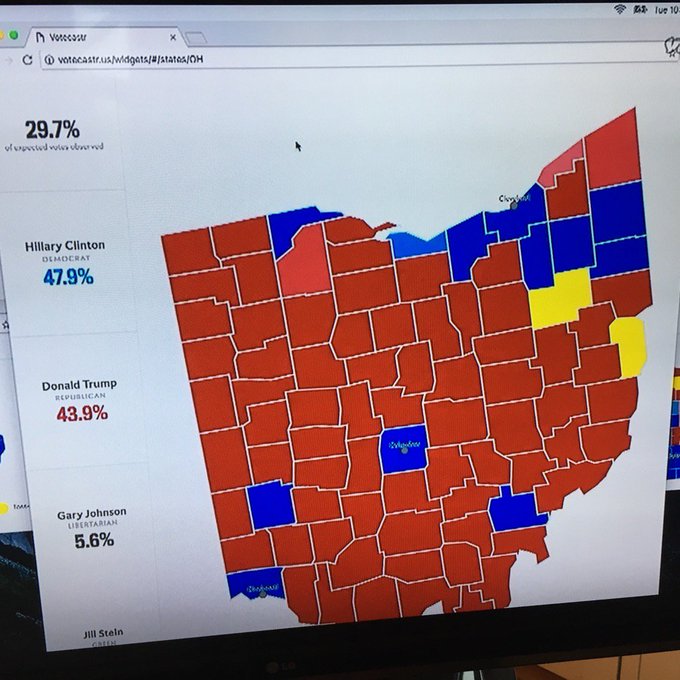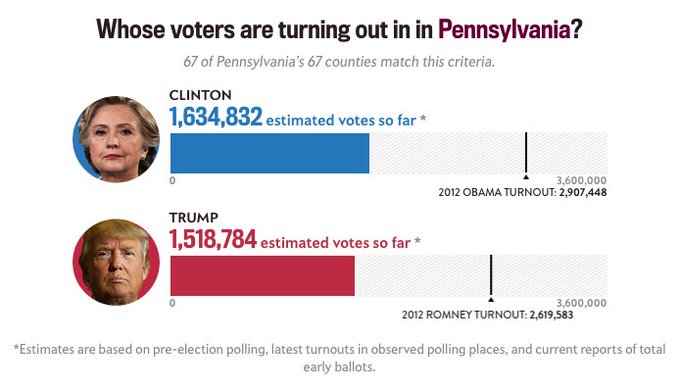Hillary Clinton is leading Donald Trump in seven key battleground states on Election Day 2016, though some races look to be close, according to early, live estimated results from the new election data service VoteCaster.
VoteCastr cautions that none of its data constitute “predictions” for who will win any specific state. For an explanation of how VoteCastr compiles voting data throughout election day, well before polls close, see the article by Slate.com senior writer Josh Voorhies at this link.
As of 7:15 p.m. Eastern Time, Clinton held leads in both Florida and Ohio — two key states that Trump must win to keep his path to the presidency alive — according to the VoteCastr data, which can be accessed via the online political magazine Slate.com at this link.
With polls just minutes from closings Ohio, VoteCastr sees the race there as neck-and-neck. Clinton has won an estimated 2,534,965 votes, while Trump claims 2,516,534, VoteCastr estimates — a difference of just over 18,000 votes statewide.
Using data from all 67 Florida counties, Clinton has turned out an estimated 4,712,021 votes so far, while Trump has collected 4,404,119.
VoteCastr also began posting county-level breakdowns for each state in the afternoon. By 5:50 p.m. VoteCastr had taken into account about 94 percent of Florida’s expected turnout, with Clinton holding a 48 percent to 45 percent lead over Trump. See the full interactive map at this link.
Clinton’s total, if accurate, would give her more votes in Florida than President Barack Obama won there in 2012. Obama, who won the state, collected 4,161,850 votes to 4,050,540 for Republican Mitt Romney.
Sorting the VoteCastr data demographically shows that in “predominantly nonwhite counties” in Florida, Clinton had 1,366,755 votes to 770,485 for Trump, a lead of more than 500,000 votes in the minority-dominated counties. But in mostly white counties, Trump led by roughly 300,000 votes, 3,008,657 to 2,703,849 in the VoteCastr estimates.
In Ohio, as of 5:50 p.m., VoteCastr had reported that Clinton had turned out 2,353,327 voters, while Trump trailed by under 22,000 votes in a nail-biting race, with 2,331,714.
In fact in the VoteTracker county breakdown, VoteCastr has Trump leading by one point, 46 to 45 in Ohio.
Much of Clinton’s total in Ohio comes from the rust-belt state’s heavily populated, urban counties. In Cuyahoga County, where Cleveland is located, Clinton led 62.6 to 30.3 percent over Trump. In Cincinnati’s Hamilton County, the Democrat held a 50 to 40.2 lead according to the VoteCastr estimate. And in Franklin County, home of the city of Columbus, Clinton led Trump 53.8 to 36.5 percent. VoteCastr had accounted for 88.4 percent of the expected turnout in Ohio.
Obama won Ohio narrowly in 2012, 50.1 percent to 48.2.
In New Hampshire, a state that had moved into the toss-up column thanks to a recent Trump surge in polling there, VoteCastr estimates put Clinton narrowly ahead with 279,140 votes as of 6 p.m. Eastern Time. Trump had collected 258,989 estimated votes.
In Colorado, Clinton has so far collected 767,953 votes. Trump’s estimate stands at 722,891 according to VoteCastr data. That’s Clinton with 46.3 percent of the vote to 43.6 for Trump, VoteCastr has calculated.

Nevada, a state where early voting results appeared to indicate a close but solid Clinton victory, saw Clinton clinging to an extremely precarious lead with an estimated 473,173 votes to Trump’s 465,706 by VoteCastr by 6 p.m. Eastern Time.
But Nevada political expert Jon Ralston saw problems with the VoteCastr results.
VoteCastr acknowledged, and said it had fixed, the error.
However, VoteCastr showed Clinton leading in Clark County, where about 70 percent of Nevada residents reside — and home to Las Vegas — 49.4 to 41.8 percent, a 7.6 point lead.
In Pennsylvania, however, the early VoteCastr count did not look nearly as good for Clinton. But by 6 p.m. Eastern she had pulled ahead in the crucial state, albeit about 130,000 votes. But her lead lagged behind Obama’s 2012 performance in the state, mainly due to an unexpectedly soft turnout in Philadelphia County, home to the state’s largest city — and the nation’s fifth-largest.
The former Secretary of State had 2,310,013 votes by the VoteCastr estimate. Trump had collected 2,170,963. Clinton is nonetheless expected to win Pennsylvania, with the final Pollster.com polling average showing her leading 46.4 to 41.2, more than a five-point polling advantage.
If the very early VoteCastr count held, Pennsylvania would have gone down as a major polling failure. But with the updated vote count, the Democratic candidate appears to be on her way to a close but comfortable victory in the state.
After a strong start for Trump in Iowa — where he was leading by nine points in the final Survey Monkey poll released on the morning of election day, Clinton had pulled ahead by 6 p.m. Eastern Time, according to VoteCastr estimates.
Clinton had 614,338 votes to Trump’s 599,045, in VoteCastr estimates.
But Iowa was another state where VoteCastr sees a disparity between vote totals and the percentages in its county-level breakdowns, as seen in the map at this link. Trump was leading by a point in Iowa in the county-level iteration of VoteCastr numbers, 46-45, with about 76 percent of the vote account for.
Clinton took an estimated 614,338 votes in Iowa, with Trump at 599,045 by 6 p.m. Eastern according to the estimated vote totals.
In a state where polling showed Clinton on her way to an easy victory, Wisconsin, VoteCastr results appear to bear out the polling prediction. Clinton had built a lead of more than 163,000 votes at 1,242,938 to 1,079,266 for Trump as of 6 p.m.
The live election day VoteCastr results are available from Slate.com at this link. VoteCastr data will also be announced and analyzed as it comes in to the “War Room” at Vice.com, in the live stream video at the top of this page.
By compiling and posting live estimated election day results before polls close, VoteCastr is breaking with a longstanding tradition in the media, in which news organizations stick to a kind of gentleman’s agreement that they will not publish or broadcast results until after polls close across the United States.
“The posture the media have collectively adopted on Election Day is paternalistic toward voters and puts journalists in the awkward and unfamiliar position of concealing information from their readers,” wrote Slate.com Editor-in-Chief Julia Turner, explaining why Slate and VoteCastr are taking the controversial step of making information on voting results public throughout election day.
“It’s also unsupported by social science. The news blackout that usually prevails is premised on the idea that publishing information about voter behavior may depress turnout. But such fears are unsupported by research. Academics examining the question have found no consistent effects on voter behavior. Which means that journalists are withholding information on a hunch,” Turner wrote.
This post will be updated with more details, as well as further data as soon as it becomes available.


